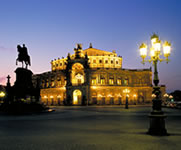Other highlights
Art & culture
The mill town of Gifhorn can look back on more than 800 years of history. At one time it was the intersection of two important trade routes: the Grain Road that ran from east to west and the Salt Road from Braunschweig to Lüneburg. Gifhorn's picturesque market square is surrounded by medieval buildings and smallholders' houses from the 16th to the 18th century, while the Guelph palace and its chapel stand proudly in the centre of town. Other attractions include the Russian cultural institute and the historical convent in nearby Isenhagen. Palace chapel
Set apart from the main building between two palace wings, this chapel serves as a museum of historical and modern religious art. Its altarpiece depicting "The Incredulity of St. Thomas" is the work of Johannes Grützke, a prominent contemporary artist. The "Rethen Crucifixion Group" by Levin Storch is one of finest religious artworks from late-medieval Lower Saxony, and ranks among the museum's most outstanding exhibits. "The Bridge" cultural institute
In September 1996, Mikhail Gorbachev assumed the patronage of Gifhorn's Russian and International Cultural Institute, better known as "The Bridge". The building itself has been designed in the old Russian style, and its 50 gilded onion domes, which stand for half a century of peace in Germany, are especially impressive. Every year, 40 talented Russian artisans get the chance to study here. The institute also enables people from all over Europe to get acquainted through creative pursuits, bridging the gap between the continent's cultures. Isenhagen Convent
This former Cistercian convent dating back to 1346 is one of the six "heath abbeys", and a number of fine artworks originating from the south-eastern Lüneburg Heath are displayed within this serene setting. Not to be missed are the two winged altarpieces carved in the Gothic style, the convent church, the nuns' chancel and the cloister with its Romanesque ornamentation and medieval furniture. Also interesting are bracteates, antependia and embroidery, including fabrics decorated with freshwater pearls from local mussels. Built in 1595, a beautiful guesthouse with ornate carvings can be found in the convent grounds. With its orchard and vegetable plots, the baroque garden is a cultural gem – opening to the public three times a year. In addition, the convent church and chapter hall stage art exhibitions and concerts as part of the Culture in the Convent festival.
Set apart from the main building between two palace wings, this chapel serves as a museum of historical and modern religious art. Its altarpiece depicting "The Incredulity of St. Thomas" is the work of Johannes Grützke, a prominent contemporary artist. The "Rethen Crucifixion Group" by Levin Storch is one of finest religious artworks from late-medieval Lower Saxony, and ranks among the museum's most outstanding exhibits.
In September 1996, Mikhail Gorbachev assumed the patronage of Gifhorn's Russian and International Cultural Institute, better known as "The Bridge". The building itself has been designed in the old Russian style, and its 50 gilded onion domes, which stand for half a century of peace in Germany, are especially impressive. Every year, 40 talented Russian artisans get the chance to study here. The institute also enables people from all over Europe to get acquainted through creative pursuits, bridging the gap between the continent's cultures.
This former Cistercian convent dating back to 1346 is one of the six "heath abbeys", and a number of fine artworks originating from the south-eastern Lüneburg Heath are displayed within this serene setting. Not to be missed are the two winged altarpieces carved in the Gothic style, the convent church, the nuns' chancel and the cloister with its Romanesque ornamentation and medieval furniture. Also interesting are bracteates, antependia and embroidery, including fabrics decorated with freshwater pearls from local mussels. Built in 1595, a beautiful guesthouse with ornate carvings can be found in the convent grounds. With its orchard and vegetable plots, the baroque garden is a cultural gem – opening to the public three times a year. In addition, the convent church and chapter hall stage art exhibitions and concerts as part of the Culture in the Convent festival.
Travel Planner
Select an option...



